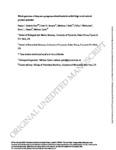Whole genomes of deep-sea sponge-associated bacteria exhibit high novel natural product potential
| dc.contributor.author | Hesketh-Best, PJ | |
| dc.contributor.author | January, Grant | |
| dc.contributor.author | Koch, MJ | |
| dc.contributor.author | Warburton, Philip | |
| dc.contributor.author | Howell, Kerry | |
| dc.contributor.author | Upton, Mathew | |
| dc.date.accessioned | 2023-02-28T16:30:26Z | |
| dc.date.available | 2023-02-28T16:30:26Z | |
| dc.date.issued | 2023-02-22 | |
| dc.identifier.issn | 2633-6685 | |
| dc.identifier.issn | 2633-6685 | |
| dc.identifier.uri | http://hdl.handle.net/10026.1/20517 | |
| dc.description.abstract |
Abstract Global antimicrobial resistance is a health crisis that can change the face of modern medicine. Exploring diverse natural habitats for bacterially-derived novel antimicrobial compounds has historically been a successful strategy. The deep-sea presents an exciting opportunity for the cultivation of taxonomically novel organisms and exploring potentially chemically novel spaces. In this study, the draft genomes of 12 bacteria previously isolated from the deep-sea sponges Phenomena carpenteri and Hertwigia sp. are investigated for the diversity of specialized secondary metabolites. In addition, early data support the production of antibacterial inhibitory substances produced from a number of these strains, including activity against clinically relevant pathogens Acinetobacter baumannii, Escherichia coli, Klebsiella pneumoniae, Pseudomonas aeruginosa and Staphylococcus aureus. Draft whole-genomes are presented of 12 deep-sea isolates, which include four potentially novel strains: Psychrobacter sp. PP-21, Streptomyces sp. DK15, Dietzia sp. PP-33, and Micrococcus sp. M4NT. Across the 12 draft genomes, 138 biosynthetic gene clusters were detected, of which over half displayed less than 50% similarity to known BGCs, suggesting that these genomes present an exciting opportunity to elucidate novel secondary metabolites. Exploring bacterial isolates belonging to the phylum Actinomycetota, Pseudomonadota and Bacillota from understudied deep-sea sponges provided opportunities to search for new chemical diversity of interest to those working in antibiotic discovery. | |
| dc.format.extent | xtad005- | |
| dc.format.medium | Electronic-eCollection | |
| dc.language | en | |
| dc.language.iso | en | |
| dc.publisher | Oxford University Press (OUP) | |
| dc.subject | antibiotic discovery | |
| dc.subject | bacterial genomics | |
| dc.subject | biosynthetic gene clusters | |
| dc.subject | deep sea | |
| dc.subject | natural products | |
| dc.subject | porifera | |
| dc.title | Whole genomes of deep-sea sponge-associated bacteria exhibit high novel natural product potential | |
| dc.type | journal-article | |
| dc.type | Journal Article | |
| plymouth.author-url | https://www.ncbi.nlm.nih.gov/pubmed/37333438 | |
| plymouth.volume | 4 | |
| plymouth.publication-status | Published | |
| plymouth.journal | FEMS Microbes | |
| dc.identifier.doi | 10.1093/femsmc/xtad005 | |
| plymouth.organisational-group | /Plymouth | |
| plymouth.organisational-group | /Plymouth/Faculty of Health | |
| plymouth.organisational-group | /Plymouth/Faculty of Health/School of Biomedical Sciences | |
| plymouth.organisational-group | /Plymouth/REF 2021 Researchers by UoA | |
| plymouth.organisational-group | /Plymouth/REF 2021 Researchers by UoA/UoA01 Clinical Medicine | |
| plymouth.organisational-group | /Plymouth/Research Groups | |
| plymouth.organisational-group | /Plymouth/Research Groups/Institute of Translational and Stratified Medicine (ITSMED) | |
| plymouth.organisational-group | /Plymouth/Research Groups/Institute of Translational and Stratified Medicine (ITSMED)/CBR | |
| plymouth.organisational-group | /Plymouth/Research Groups/Plymouth Institute of Health and Care Research (PIHR) | |
| plymouth.organisational-group | /Plymouth/Users by role | |
| plymouth.organisational-group | /Plymouth/Users by role/Academics | |
| plymouth.organisational-group | /Plymouth/Users by role/Researchers in ResearchFish submission | |
| dc.publisher.place | England | |
| dcterms.dateAccepted | 2023-01-18 | |
| dc.rights.embargodate | 2023-3-2 | |
| dc.identifier.eissn | 2633-6685 | |
| dc.rights.embargoperiod | Not known | |
| rioxxterms.versionofrecord | 10.1093/femsmc/xtad005 | |
| rioxxterms.licenseref.uri | http://www.rioxx.net/licenses/all-rights-reserved | |
| rioxxterms.type | Journal Article/Review |


